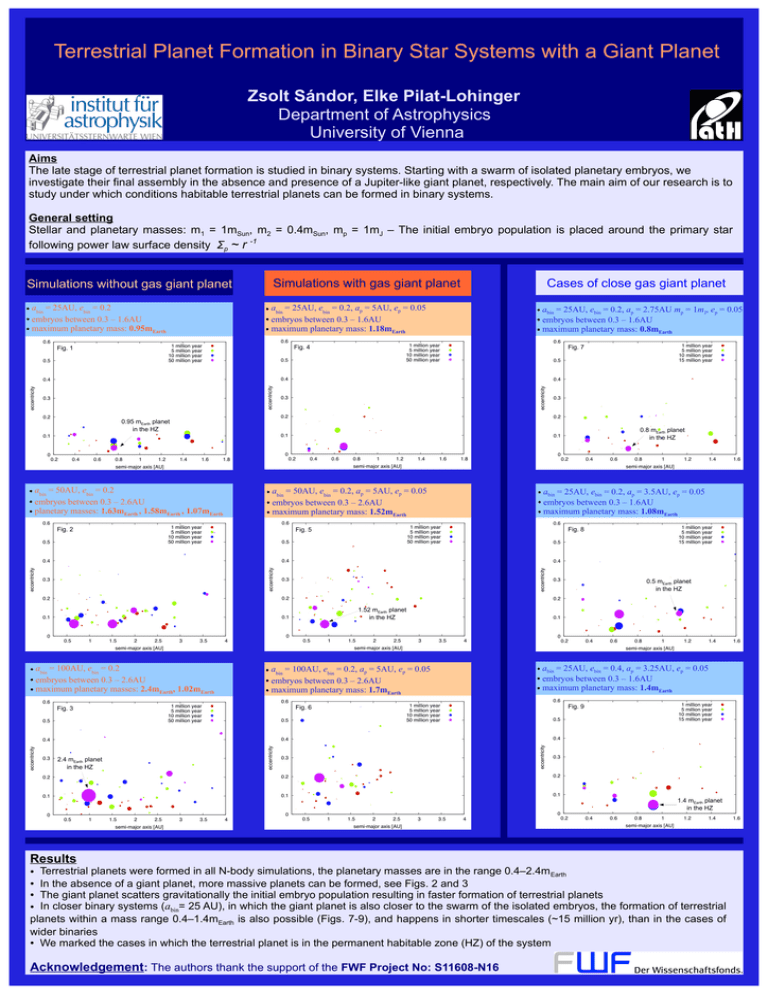Terrestrial Planet Formation in Binary Star Systems with a Giant Planet
Werbung

Terrestrial Planet Formation in Binary Star Systems with a Giant Planet Zsolt Sándor, Elke Pilat-Lohinger Department of Astrophysics University of Vienna Aims The late stage of terrestrial planet formation is studied in binary systems. Starting with a swarm of isolated planetary embryos, we investigate their final assembly in the absence and presence of a Jupiter-like giant planet, respectively. The main aim of our research is to study under which conditions habitable terrestrial planets can be formed in binary systems. General setting Stellar and planetary masses: m1 = 1mSun, m2 = 0.4mSun, mp = 1mJ – The initial embryo population is placed around the primary star -1 following power law surface density Σp ~ r Simulations with gas giant planet Simulations without gas giant planet abin = 25AU, ebin = 0.2 ● embryos between 0.3 – 1.6AU ● maximum planetary mass: 0.95m Earth ● abin = 25AU, ebin = 0.2, ap = 5AU, ep = 0.05 ● embryos between 0.3 – 1.6AU ● maximum planetary mass: 1.18m Earth ● Cases of close gas giant planet abin = 25AU, ebin = 0.2, ap = 2.75AU mp = 1mJ, ep = 0.05 ● embryos between 0.3 – 1.6AU ● maximum planetary mass: 0.8m Earth ● Fig. 4 Fig. 1 Fig. 7 0.95 mEarth planet in the HZ abin = 50AU, ebin = 0.2 ● embryos between 0.3 – 2.6AU ● planetary masses: 1.63m Earth , 1.58mEarth , 1.07mEarth ● 0.8 mEarth planet in the HZ abin = 50AU, ebin = 0.2, ap = 5AU, ep = 0.05 ● embryos between 0.3 – 2.6AU ● maximum planetary mass: 1.52m Earth ● Fig. 2 abin = 25AU, ebin = 0.2, ap = 3.5AU, ep = 0.05 ● embryos between 0.3 – 1.6AU ● maximum planetary mass: 1.08m Earth ● Fig. 8 Fig. 5 0.5 mEarth planet in the HZ 1.52 mEarth planet in the HZ abin = 100AU, ebin = 0.2 ● embryos between 0.3 – 2.6AU ● maximum planetary masses: 2.4m Earth, 1.02mEarth ● Fig. 3 abin = 100AU, ebin = 0.2, ap = 5AU, ep = 0.05 ● embryos between 0.3 – 2.6AU ● maximum planetary mass: 1.7m Earth ● Fig. 6 abin = 25AU, ebin = 0.4, ap = 3.25AU, ep = 0.05 ● embryos between 0.3 – 1.6AU ● maximum planetary mass: 1.4m Earth ● Fig. 9 2.4 mEarth planet in the HZ 1.4 mEarth planet in the HZ Results Terrestrial planets were formed in all N-body simulations, the planetary masses are in the range 0.4–2.4m Earth ● In the absence of a giant planet, more massive planets can be formed, see Figs. 2 and 3 ● The giant planet scatters gravitationally the initial embryo population resulting in faster formation of terrestrial planets ● In closer binary systems (a bin= 25 AU), in which the giant planet is also closer to the swarm of the isolated embryos, the formation of terrestrial planets within a mass range 0.4–1.4mEarth is also possible (Figs. 7-9), and happens in shorter timescales (~15 million yr), than in the cases of wider binaries ● We marked the cases in which the terrestrial planet is in the permanent habitable zone (HZ) of the system ● Acknowledgement: The authors thank the support of the FWF Project No: S11608-N16